- Would you begin by telling us about yourself before you began contact Gonzo? Were you involved in some form of physical expression or dance activities?
-
I was born in 1979 in the Shugakuin district of Kyoto. Because of my father’s job transfer I spent the first three years of elementary school in the state of Virginia in the USA. After returning to Japan I lived in Suita city in Osaka until I graduated from high school. When it came time to go to college, I didn’t really know what I wanted to study. Through middle school and high school I had played soccer and wanted to continue it, but I wasn’t good enough to become a pro, so I gave it up at that point. I thought that if I entered the art department of some university I could spend four happy years absorbing myself in the things I liked best after soccer, which were film and music. So, I enrolled in the art department of the School of Literature of Kansai Gakuin University.
At first I studied photography and film. I decided to study all the photography collections in the library, which led me to the discovery of the art photography book Kamaitachi by Eikoh Hosoe, photographing the butoh pioneer Tatsumi Hijikata. I was surprised to find someone doing this kind of art. As I began doing research to find out what kind of artist Hijikata was, I discovered the existence of this dance form called butoh for the first time. Doing more research, I learned that butoh was now being performed as a form of contemporary dance or a form existing in parallel with it. That led me to change my major course of study to dance and begin researching various materials on dance in the internet or in the library. One of the visiting instructors at our university was friends with Iku Otani, the producer of Dance Box (hereafter dB *1 ). What’s more, learning that Otani-san was about to open a small theater at Osaka’s Festival Gate at the time, I went to visit his office. They were looking for volunteer staff members at the time and asked them to use me if there was anything I could help with.
I did that because I didn’t have the money to go around seeing all the performances that were happening, and I knew that if I didn’t see the performances that were out there, my research wouldn’t go anywhere. So, volunteering to work at the theater was a way of getting closer to the productions and seeing the behind-the-scenes realities that just watching performance videos could never provide. That was in 2002 during my fourth year at university. - Contemporary dance was very active at the time and dB was a leading theater in the Kansai dance scene. So, being there, you had truly put yourself in the middle of that scene, hadn’t you? I imagine that the dance you had seen on videos in your research up until that point had been representative works of the famous artists. What did you think about the dance you were then seeing at dB?
-
The things I had seen from our university library collection were things like the dance works of LaLaLa Human Steps and Rosas and movies directed by Pina Bausch, etc. I also went to see famous works performed at the Biwako Hall, and our seminar professor, Shozo Nagata was a researcher in the performing arts, so he was able to show us things like Robert Wilson’s
Einstein on the Beach
and films of things from New York in the 1970s and ’80s.
So, when I first started watching performances at dB, at first I felt it was a rather minor scene. Information about the local artists of the Kansai area had never made its way up to the university library, and my personal antenna had not been pointed in that direction either. When I first began watching performances and becoming involved in productions at dB, I realized that there was a world where things had to be created from scratch. For example, the CDs you find in the stores are already finished products and, naturally, you don’t see the process by which the contents are made, but at dB I was able to see what was in effect the factory where works were being made. What’s more, I had the impression that it was a “dance factory” where quite minor works were being made.
At the time there was truly a diverse program of dance being performed at dB and it appeared to me to be something like a shelter for people who didn’t fit into the conventional styles of dance. For example, there people who wanted to create works that didn’t if into the conventional jazz dance genre, so they were presenting their works in the context of contemporary dance. There were also people who had come from butoh and were trying to approach contemporary dance from that direction. The first generation of artists in the Kansai contemporary dance scene had been the people at selenographica and CRUSTCEA and Yazaki Takeshi, and I believe that when I began working at dB it was around the time when the second generation of artists was emerging. - What kinds of work were you actually assigned to at dB?
- At first I was a member of the production team for the Asia Contemporary Dance Festival and in that capacity I was doing interviews and writing articles for db’s publications. After that I was assisting in the area of writing up contracts and such for visiting foreign artists and technical translators/interpreters, etc. in the foreign business area, while at the same time I was in charge of production for the step-up program that began with Dance Circus and progressed to the Dance Box Sessions and One Dance programs. After I finished graduate school in 2004 I went to work as a full-time employee of dB. We were organizing a lot of performances, so I would be involved in the production and see the dance works and then go out drinking with them after their performances. Of course I was doing a lot of thinking about the works I was seeing, but I was happy doing what I was doing. What I wanted to do most of all was to be close to the works in progress and see how these “artists” made decisions about the various things involved in the creative process.
- Clearly you had entered dB in large part from the standpoint of a researcher, but didn’t you ever get the desire to dance on stage yourself at that time?
-
At the time I was inspired by Hijikata and I was interested in butoh workshops, but I was too embarrassed to actually dance myself. So I spent all that time just watching. I felt a distance from the type of presence called and “artist” and that it was not the job I was meant to do. However, as I watched the performances from the wings of the theater, I would find myself doing simulations [of dance] in my mind. That became the foundation for what I am doing now, I believe. But at that time, I had decided not to participate in dance workshops.
At the same time, I found myself becoming increasingly interested in one of the dancers performing at that time, Masaru Kakio, who later established contact Gonzo. His dance works were unique. He would often do a considerable amount of talking as he did his improvised dance performances. He might say, “To finish with, I am going to run on the wall.” Then he would run a couple of steps up the wall. He also did “people works” where he just lined up people on the stage floor. There was a lot of what you might call yuragi (shifts from the norm) it today’s terminology. One thing that was especially interesting to me was the fact that Kakio-san was not someone who had been doing dance from a young age but was someone who had been doing something else and came to dance rather late. The same is true with Zan Yamashita, isn’t it? It always seems to be someone like that who can bring a completely different perspective.
That is why I invited Kakio-san to join in the Senboku Art Project that dB was involved in. It was a project that ran from November 2004 to March of 2005 and involved a series of “town art” events in the towns along the Senboku Express Train Line that would consist of documentary type dance works performed at parks. My intention with this project was to take a bunch of artists, as people who can shake up the norms of society, and turn them loose in the system of large parks that had been created as islands of greenery in the planned residential communities that had been built along the commuter train line.
Kakio-san was interested and we went to one of the parks with no particular plan in mind about what he would do. There, on the first day of the project, he suddenly said he was going to do “falling leaf catches.” Then he began racing after falling leaves trying to catch them in mid-air. I followed along and filmed him doing it. At the end of the three months of the project I edited all of the video footage I had taken into an hour-long film and had a showing of it. In the process of doing these things together Kakio-san and I came to understand each other’s tastes and values, so even after the project ended we continued to meet and go out drinking or mountain climbing. After about a year of that, I got an email from Kakio-san saying, “Let’s do contact.” - Kakio-san is a dancer with a strong presence who has been an essential part of Zan Yamashita’s works. He also performs in the works of companies like the Kobe-based Ensemble Sonne and the Tokyo-based Dance Theater LUDENS that require dancers of high technical skill. We have learned that contact Gonzo is a performance group that evolved on the relationship of trust between you and Kakio-san, but did you understand what Kakio-san meant when he suggested that the two of you do “contact.”
-
I understood it to be a new kind of recreation. When we would go mountain climbing we often went off the trail intentionally to break through the bush or climbed cliffs. So I was used to his spirit of fun. The first thing we did was to gather in Ogimachi Park in the middle of Osaka and began playing in the method of “contact improvisation” that Kakio-san had learned in workshops.
Later he found an article Systema in his favorite martial arts magazine, Monthly Hiden , and said it looked interesting. Systema is a Russian form of martial arts that is likened to Japanese Aikido. It apparently involves maintaining steady breathing, staying relaxed, keeping a straight posture and keeping in constant motion as its basic physical principles, and rather than attacking and overcoming the opponent, it adopts the approach of trying to understand your opponent’s movements (which is similar to contact improvisation). So, what we were doing was our own form of “play Systema” that involved imitating its flowing movements or facing each other and slapping each other on the face with increasing strength. And then there is Parkour , the performance they do in France jumping from one building to the next. We did a variation in the parks, climbing up inclines or drop-offs and then jumping off or such. For several months we would meet at a park and have fun doing a variety of contact techniques. In the process we invented a number of new movements like pushing in a way that looked like punching or slapping and reeling back as if hit.
Just around that time we learned about the foreign website YouTube and began uploading video clips of our performances on it. - Looking at those early video clips, we see two men facing each other with serious expressions in parks or on the streets or in bamboo groves and punching or slapping each other. Yet there is none of the tension that would normally be attached with the violent acts of punching or slapping. Rather, the appearance is that of speedy and gentle improvisational movement. At a glance it could also be likened to martial arts practice, and it could even be seen as a graceful form of dance. In contrast to these movements, there are at times the very real sounds of the bodies being slapped or plastic bottles rolling across the floor. It is an approach that is entirely different from conventional contemporary dance in the way it is made and shown. It seems to me that from this point you already had the basic style of contact Gonzo. Where did the name contact Gonzo come from originally?
-
We had decided to enter the Osaka 21st Century Association’s 720@PAMO AWARD 2006 in hopes of winning the prize money, but it turned out that we needed a name for our group. So we had to think up a name.
The word Gonzo comes from the term Gonzo journalism (*2) . When I was in college I was influenced by the books of Hunter S. Thompson, and among them was a report on which the movie Fear and Loathing in Las Vegas is based that really impressed me. At the time, contemporary dance was beginning to establish its own “dance literacy” (ability to shape and understand meanings in dance), but what we were doing wasn’t related to its norms, as we used no lighting effects, didn’t rehearse and had no real concept of what constituted a [composed] dance work. And since the things we were trying to do were the exact opposite of the existing norms of contemporary dance, much as Thompson rejected the accepted conventions of “clean” journalism (accepted journalistic literacy), we thought we could use the English slang expression “Gonzo” that was used to describe Thompson’s type of subjective journalism that broke the rules of journalistic objectivity and was therefore regarded as irresponsible or unfounded. To be grammatically correct, Gonzo would normally be used an adjective in the form “Gonzo Contact,” but since the rhythm of that didn’t sound good to our ears, we turned it around and called ourselves “contact Gonzo.” - For you, what was the significance of working outside the norms of conventional dance literacy?
-
What I was involved in most of all at dB was working with the “third generation” of dancers that were beginning to appear at the time and were about the same age as me. Students came saying that they wanted to do contemporary dance and we had opportunities for them to dance. However, if contemporary dance was originally a sort of shelter for artists who didn’t fit in the other dance methods (genre), and in that sense a negative genre, then people would not have come to us saying that they wanted to do contemporary dance in the first place. Therefore, I believe it was not the name of a genre.
In order to create a place where people could come with crazy ideas and produce pure and strong works of dance, I felt that it would be best to say that there was such a thing as contemporary dance literacy already established and then have people working outside [on the fringe of] those norms to stir things up. Otherwise, I felt, the genre would not expand. That is why I wanted to be on the fringe doing crazy things. Anyway, I have always had a preference from crazy things in my nature.
In the end we weren’t selected as finalists for the PAMO Awards that year, but I did hear from people that one of the members of the awards jury, the leader of Ishinha, Yukichi Matsumoto, saw our video and said it was good. That was enough for us. - The first time you performed in front of an audience was at the “Dance Circus 100 in a Row!” celebrating the 10th anniversary of dB in October 2006. This was a showcase type performance. What did you want to show with it within the category of contemporary dance?
-
It was a 7-minute performance and for it we added to our usual performance a part at the beginning and end where people walked with blindfolds. When the French choreographer Jean Gaudin saw that he got a bit angry. When he was invited to Japan by the Osaka Contemporary Art Center, I had served as his guide and interpreter, so he came to see our performance. He said that what we were doing was very interesting as it was and there was no need to try to add story elements to it. He said, “Needless staging like that can distract the viewer from seeing some of the more important parts. The audience will understand your work without the addition of a narrative.” That cleared my mind. It made me confident that people would understand what we were doing without any unnecessary decoration.
The next year, one of my classmates from college, Keigo Mikajiri, joined us and we entered the PAMO AWARD 2007 contest as a trio and won the grand prize. He had played rugby through high school, and his addition as a third performer increased the dynamics to the point where a lot of unexpected things would happen. Until then the dynamics of our performance (Kakio and Tsukahara) had been two-directional, but the addition of a third person began to add new twists to the directional arrows. This became another turning point for contact Gonzo. - One thing that characterizes contact Gonzo activities is the way that video and photographs are integral elements along with the performance. In a work like your the first man narrative where there is simultaneously broadcast video and photographs that you take of yourselves in the midst of the performance. What are you trying to show with this media mix?
-
The Gonzo concept has already been applied to pornography and photography and a lot of influences have gone into it. What’s more, following up on the Senboku Art Project, I had continued to film with the idea of making a “Park Film II” and had been having fun uploading them on YouTube. When I film it is always in the same simple style, with just a few cameras set in fixed positions on tripods. I mean, with the kind of hitting and physical contact that contact Gonzo is doing, anyone could use top equipment, skillful editing and music to make a slick, sexy film with polish like a TV commercial. I wanted to do the opposite of that, and I thought that would better communicate the simple, unadorned nature of Kakio-san’s work.
Thanks to the YouTube videos, the critic Osamu Nakanishi began writing about us, and Yasuo Ozawa of Japan Performance/Art Institute who serves as a producer for performances, and the critic Keisuke Sakurai began inviting us to Tokyo to perform, which gradually expanded our range of activities. For me, YouTube is my world dictionary and I have the sense that uploading handmade, un-sexy videos there keeps us connected with the world. - After that you participated in the Yoshihara Jiro Memorial Art Project (*3) in the art field. What was your motivation for that?
- This takes us back to what I was saying earlier about working outside the context of contemporary dance and the belief that such efforts to stir up things on the fringe, in the case outside the context of contemporary art as well, could have a positive effect in making both scenes freer. From my studies a university I had some basic knowledge of art. What we were trying to do in this project was to find approaches for asking ourselves what contact Gonzo is, and I thought that people from the art world could give us a wide scope of ideas.
- Five artist-art coordinator pairs are selected and after six months of studio work the winning artist (or group) is selected and works with the art coordinator on the final output and the resulting exhibition is created. You, contact Gonzo, were selected as the winning artists. I saw the documentary produced about your project and it indeed had the appearance of a journey in search of self-definition.
-
We planned to gather a variety of people in the studio and have them discuss a definition for contact Gonzo. In short, by surrounding ourselves with a variety of definitions made from different standpoints, we wanted to avoid being understood in terms of a single definition. By showing improvisational acts of hitting and bumping into each other and there is a possibility that we could be judged simply in terms of concepts in directions such “speed” and “destructive force.” I was afraid that people would miss the simple, unadorned nature of Kakio-san’s work that I tried to show in the documentary videos; the central core of shifting ambiguity I wanted to preserve.
In the midst of it all, what I found interesting was the definition presented by professor Masaru Nishikawa of the Osaka University Communications Design Center. From his perspective as a medical philosopher who had spent long hours as a nurse in contact with the pain and suffering of many patients in hospitals, he gave us words that impressed me greatly when he said it is not a matter “elasticity” or “qualities of impulse” and it doesn’t “end with the hit.” Rather it is a matter of the fact that the “hit leads to the next action.” - As ensuing parts of your Yoshiwara Art Project you then traveled to Finland, China, South Korea and Okinawa. The project title at that time was MINIMA MORALIA.
-
MINIMA MORALIA is the title of a book by the philosopher Theodor W. Adorno. Looking back I think it may have been a bit pretentious, but I thought the name fit with feeling that we wanted to make it a slow, quiet journey.
The first destination of the journey was the underground nuclear shelter in Helsinki, Finland. Normally it is open to the public and it has extensive facilities like pools, libraries and skate parks. I went to see it because I was interested to see what it was like living in the vicinity of such a facility. After that I had one of the contest’s judges, the museum curator Fumihiko Sumitomo take us along with him to China and South Korea and the performance videos made at these destinations became the first pages of the international section of contact Gonzo’s performance video archive. We did installations with our performance videos and photographs at the exhibitions we participated in, and they consisted of a bridge installed with videos from Ogimachi Park and image photographs of the countries we visited plus a swaying floor that was built for us by a carpenter named Taruto Shirafuji.
Looking back, we were very fortunate to be able to spend so much time and resources on our work during that project. I learned that we were working in a method that was different from most performing arts creative processes from a practical standpoint as well. - In the contact Gonzo profile we see the words defining a pursuit of “Philosophy of pain, technique of contact.” These words suggest a strong sense of social relevance. Is that one of your intentions?
-
The reason we used that kind of terminology at first was as a form of defense based on ambiguous, generalized working in order to avoid being spoken of in definitive terms, as I mentioned earlier. But now, I feel we have reached the point where we can perform freely without such words, so we don’t use them much anymore.
I studied sciences through high school and was especially interested in physics. Dance gives rise to emotions and sensations based on things that happen during the performance, in a sense like, “That speed is good,” or, “This slowness is good.” But, if you ignore that type of sensibility, it is possible to look at the body not as a medium for expressing emotions but simply something to be seen as a series of physical phenomena. For us [contact Gonzo], we are not concerned with “internal/emotional” reasons for our movement. It is merely a matter of [I moved because] “my body was pushed.” Looking at the video you can express all of the motion in terms of arrows delineating the vectors of movement. Thinking in those terms, I believe you could say that the body is not a medium but an entity that, in itself, is embodying philosophy.
As for the concept of “pain” as well, it is not the pain caused by the violence in society but pain that can be thought of in terms of the tactile sense and the nervous system. What we are doing is not causing damage to the other person but simply applying force that produces what in the terms of physics would be called vectors of movement. If the interval of contact is short it is interpreted as striking the person. Our “contact” is very unemotional. As an event it is on the same level as a plastic bottle falling over. That is the meaning of our “Philosophy of pain,” but it is very difficult to explain. In short, it is because we have been thinking about the meaning after making that initial general statement. - It seems that if you subtract the emotional elements from physical sensibilities and take a purely physical approach to the sensations of the body it would be possible to define movement in objective terms like speed and weight, but did the word “pain” somehow suit you better?
-
Perhaps the word “shock” would have been equally good. But, even though we were using the word pain, the performance itself was so unemotional that it may have highlighted the extremely flat physical sensibilities even more.
If you translate it into the everyday, sports are basically the only context where we are pushed by others. And if we are pushed by a stranger on the street even a little bit it is a shock that makes us shudder, doesn’t it? It is a feeling similar to that. What we are doing is a sort of a form of physical play in which the other person experiences something unexpected and it bounces back at you, and the repetition of these reactions can swell into something like a big wave and we may or may not be able to ride that wave. It is fascinating because you don’t know what is going to happen until you actually go out there and do it.
Or it may be that we are building an absoluteness in a world of our own by attaching a high level of spiritual or intellectual significance to what actually small, insignificant events. But there are times when new things are revealed by making grand statements about otherwise insignificant things. - You said earlier that when you first saw the [butoh] work of Tatsumi Hijikata you thought it was cool. How do you evaluate Hijikata as an artist?
-
I believe he was an amazing strategist. Especially what we see in the films of his early work appears to me to be what we would call “remix” today. It is said that he originally studied the new German dance form known as “Neuer Tanz” and from his working notes it is evident that he got inspiration from the paintings of Francis Bacon and Egon Schiele. I feel that by remixing a number of surrealistic elements he was able to create amazing dynamic “noise.”
When I came back to Japan from the US as a child my identity was half Westernized. But after that when I spent time in London as a Reuter intern in high school I found that people there thought it was strange that I, as a Japanese, was listening to foreign music. It was from the way the people around me looked at me that made me realize that I was Asian. I thought I wasn’t in the world that I had been longing for, but I wasn’t really there. So, what weapons did I have to compete with? I had been surrounded by the music of the Beatles since I was born, and it was too late to begin going back to traditional [Japanese] culture. I wanted to wear jeans to school, too. When I was questioning what I should cling to, I discovered Hijikata. I felt that he was one who probably had a lot of Western culture in his background but never denied or negated it and was able to speak his mind as a Japanese who was moving forward as a work in progress, and that opened my eyes and made him look really cool to me. It is the same with Western aesthetic and painting. I felt that there was a need to make a drastic change in my point of view and to look at what is considered ugly or dirty and not dismiss it as “ugly” but look at it as the everyday and as oneself.
At the same time, [Hijikata] made me think about the relationship between the words and the body. The name Hijikata chose for his butoh “ Ankoku Butoh ” was cool too, but I feel that his movement became entangled in the many other words that were born from his activities and his later work lost its momentum as a movement because of that. Once you become defined by words you reach completion as a movement and there is nowhere to go from there. That is why in contact Gonzo we believe that looking full of meaning and surrounding ourselves with words that don’t define events or meaning gives you more freedom.
In the past I thought that being an artist wasn’t my calling but now I use the weapons I have to stand on the stage and compete. And I make my own rules for standing on the stage. In that sense, too, I have been influenced by Tatsumi Hijikata. - 2011 sees the start of AI HALL’s “Take a Chance Project.” In this project a Kansai-based choreographer or director is chosen to do one work a year over a 3-year period. This is a program for creating what one would call theater pieces. Do you have any specific ideas concerning this project?
-
Basically I am thinking about how I can translate the stance we have built up in our activities so far into a piece for the theater stage.
One hint came from the dance performance SAALEKASHI that was staged in September 2009 as part of the AI HALL Chiiki de Tsukuru Butai (Stages Created By Communities) series. It was performed by Osamu Jareo’s team (students from the Kobe Women’s College where Jareo teaches) and involved devices such as a catapult that things flying across the stage when the dancers pulled its rope and a stage space defined by flat platforms arranged into forms like a path. The involvement of these things in the dance would create a strange sense of timing at times, or none at all at other times, and a parachute that comes falling down would tangle up one of a group of dancers. And all this was involved with Jareo-san in a “chance operation” type atmosphere.
Perhaps from my experience of watching performances of works from the wings at dB, I have an interest in methods and devices that are normally used for hiding things from the eyes of the audience, such as scene changes, masking gaps and floor markers. Although showing those things is something that is not allowed in normal theater, I believe that it can be valid to use a approach that deliberately employs that kind of twisted viewpoint in the composition of the [performance] space. - It seems that foreign presenters are interested in your ability to bring a breath of fresh air into the contemporary dance scene. How do you feel about this?
-
This summer we will be touring festivals in five countries including Germany and the Netherlands. Ninety percent of the performances will be in theaters. Normally the performance time is about 30 minutes, which is a bit different from what you would call a full evening performance (laughs).
Probably the reason we are invited to festivals is basically as an act to add to the mix. I somehow get the feeling that it would be difficult to include us if there were only three acts on the program, but if there are five or more, then we could add variation to the program. For us, it doesn’t matter what spot we perform in, but if we can bring a breath of fresh air or reverse the stream, I’d consider that a big success?
The strength of contact Gonzo depends on how honest our performance is. If you are honest with regard to the situation, the fellow performers and the audience, and if you give it your best, something will be communicated. The performances where we have been able to do that have brought results, so this is something I am certain about. Even if it is an artist working with a completely different method or philosophy, if they are honest people will see it and say, for example, “Ikuyo Kuroda’s movement is really honest,” and so they believe in them as artists and come to see their performances. It is the same with us and that is what we have to believe in.
I don’t know how much we will be able to shake up the fringe of contemporary dance by doing our wild things, but we will continue to do our best, without trying to be overly responsible. Or, perhaps it is better to say that that we will perform our crazy stuff like crazy (laughs).
Yuya Tsukahara
Playing with physical contact contact Gonzo
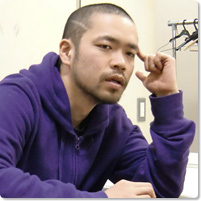
Yuya Tsukahara
Born in Kyoto in 1979. In 2006 Tsukahara formed the unit contact Gonzo with Masaru Kakio in Osaka. The unit began performing in parks or on the streets in an improvisational style of physical contact that explored what they termed “Philosophy of pain, technique of contact.” They also began taking large volumes of photographs in a method called “the first man narrative” that involved taking photos of each other’s actions and they began uploading video clips of their performances on YouTube in real time. In 2007, Tsukahara and contact Gonzo won the grand prix “720@PAMO AWARD” of the Osaka Performing Arts Messe. The same year contact Gonzo was selected for the Jiro Yoshiwara Memorial Art Project organized by the Osaka Contemporary Art Center, traveling to Helsinki, Nanking, Seoul and Okinawa as part of the project. This resulted in the creation of “project MINIMA MORALIA” performed in 2008. After this Tsukahara and contact Gonzo became the focus of increasing attention in both the performing arts and contemporary art scenes that led to participation in international exhibitions and arts festivals such as the Nanking Triennale 2008 and the Aichi Triennale 2010. Currently contact Gonzo consists of four members, including Tsukahara, Yu Kanai, Itaru Kato and Keigo Mikajiri, and their varied activities involve performance and creation of installations in a variety of venues in Japan and internationally and publication of magazine. Tsukahara is a graduate of the art course of the Literary Research Dept. of Kwansei Gakuin University. He currently lives in Osaka.
https://www.youtube.com/user/contactGonzo
Interviewer: Matsue Okazaki / Representative, Offsite Dance Project [NPO])
*1
Dance Box: An NPO founded in 1996. From 2002 to 2007 it ran a small theater in Festival Gate named Art Theater dB. After the closing of Festival Gate, it moved to offices in Nagata Ward, Kobe in 2009.
https://www.db-dancebox.org/
*2
*2)
Gonzo journalism: Hunter S. Thompson’s original and unique style of journalism that disregarded the conventional rules of objective, factual journalism making himself a journalistic subject in an attempt to get closer to the true realities.
*3
An art project competition organized by the Osaka Contemporary Art Center. Contestant artists chosen for the first stage work with art coordinators to put on exhibitions, lectures, etc., primarily in studios from which a single winning artist and art coordinator are chosen in the second stage of judging. Then a year is spent to complete the project and give a presentation. In all, this makes it a 3-year project.
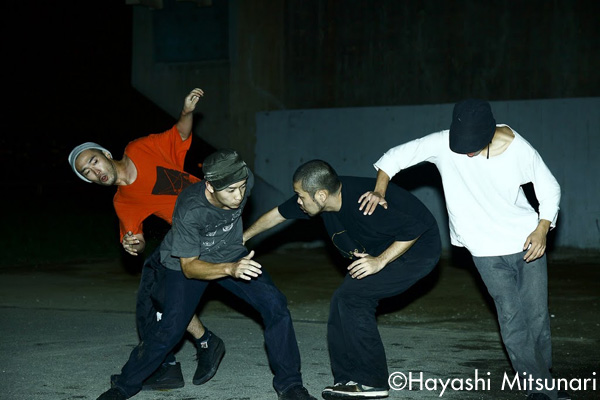
©Hayashi Mitsunari
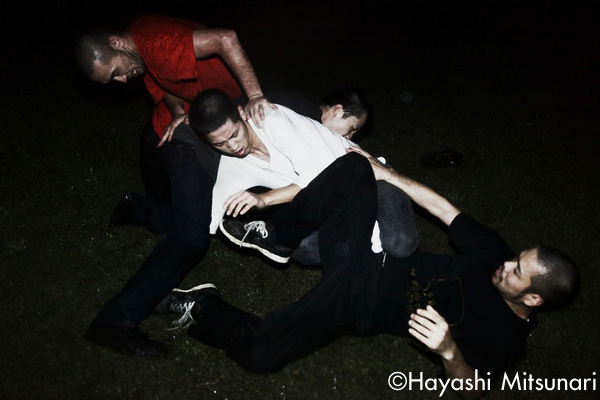
©Hayashi Mitsunari
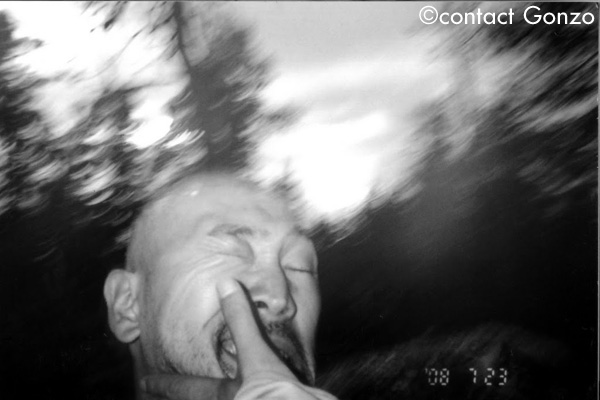
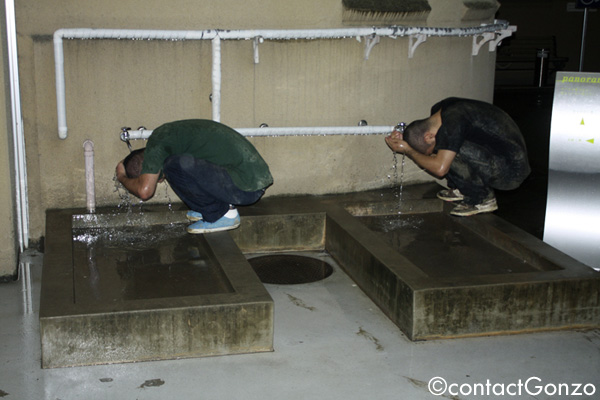
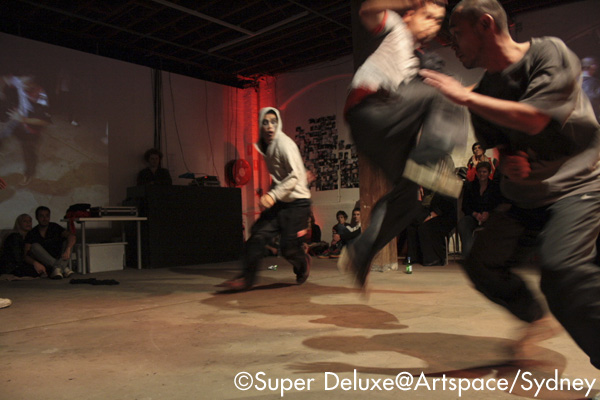
Performance at Super Deluxe @ Artspace, Biennale of Sydney (2010)

Installation at “Roppongi Crossing 2010” (Mori Art Museum)
©Kioku Keizo
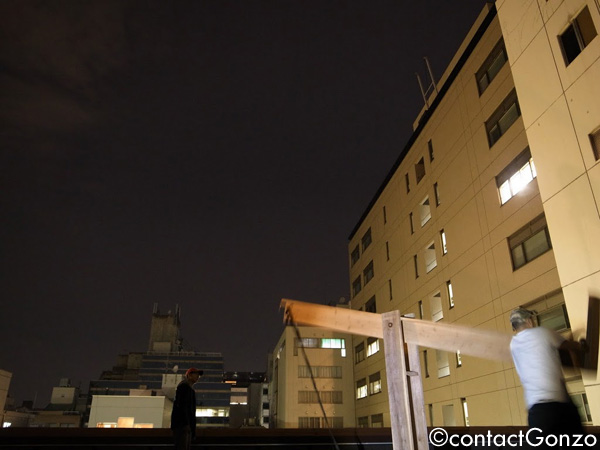
AI HALL
Chiiki de Tsukuru Butai
series
Osamu Jareo/Yuya Tsukahara
SAALEKASHI
(Sep. 2009)
Related Tags

